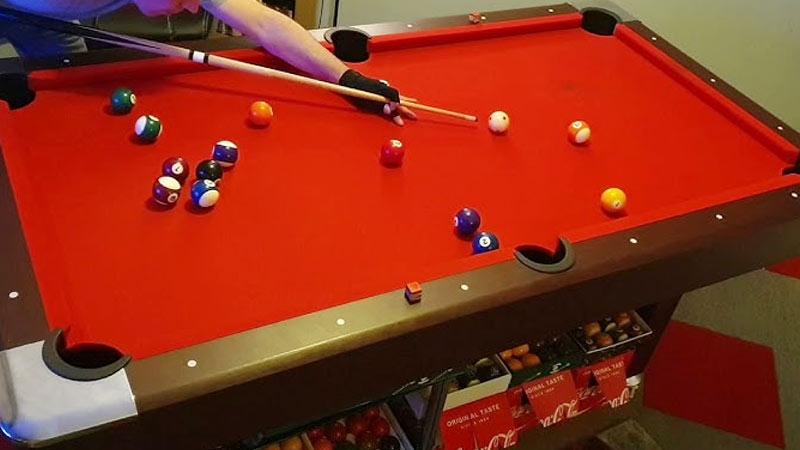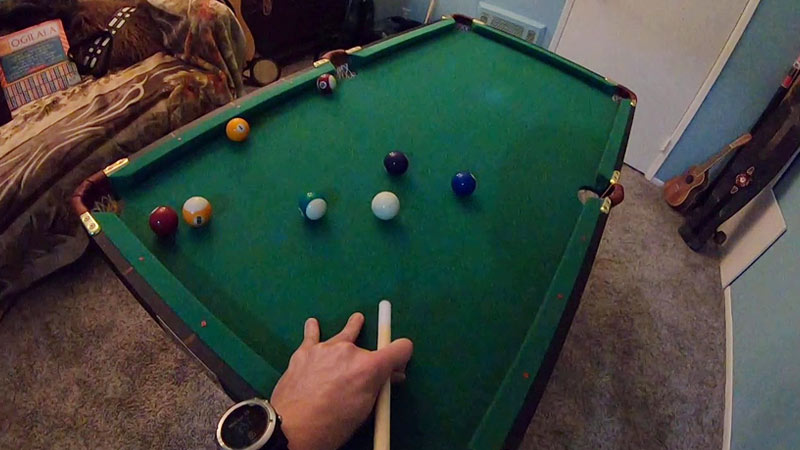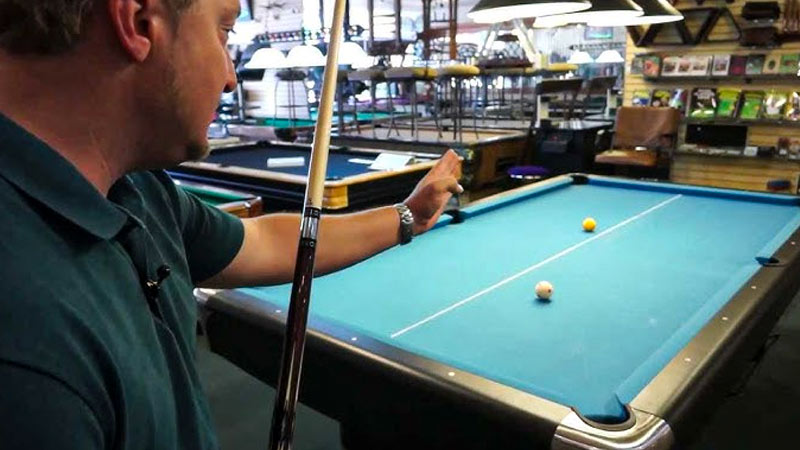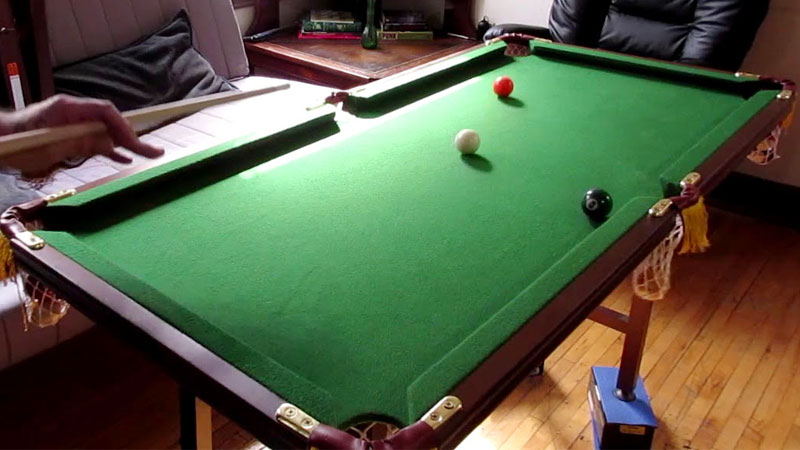The allure of a well-placed pool table in your home or entertainment space is undeniable. It’s a hub for camaraderie, competition, and countless hours of fun.
However, before you rush into setting up your beloved billiards corner, there’s a critical question to address: Is 4 ft around a pool table enough?
This blog post dives into the essential considerations and trade-offs that come with this spatial constraint.
As we explore the pros and cons of a 4-foot clearance, you’ll gain a deeper understanding of how room dimensions impact your pool-playing experience.
We’ll discuss the advantages of space efficiency and cost savings but also shed light on the limitations, like restricted gameplay and the potential for accidents.
By the end of this discussion, you’ll be better equipped to make an informed decision regarding your pool table setup. So, stay focused.
Is 4 Ft Around a Pool Table Enough?
A 4-foot space around a pool table is generally not enough to provide a comfortable and safe environment for playing.
The standard recommendation for a pool table room is to have at least 5 feet of clear space around all sides of the table.
This extra space ensures that players have enough room to cue properly, take shots from various angles, and move around without bumping into walls or obstacles.
A larger clearance also helps prevent accidental damage to the table or the surroundings during gameplay.
While you might be able to squeeze a table into a smaller space, it is likely to hinder the quality of play and increase the risk of frustration and accidents.
It’s advisable to prioritize a more spacious area for an enjoyable and safe pool-playing experience.
How to Measure Pool Table Dimensions?
Measuring the dimensions of a pool table accurately is important when planning its placement or for any other purpose.
Here are the steps to measure a pool table’s dimensions:
Table Length

Measure the length of the table from the outside edge of the cushion on one end to the outside edge of the cushion on the other end.
Be sure to measure from the farthest points on each cushion, not just the visible playing surface.
Standard pool tables come in various sizes, but common sizes include 7 feet (bar/pub size), 8 feet (home size), and 9 feet (tournament size).
Table Width
Measure the width of the table from the outside edge of the cushion on one side to the outside edge of the cushion on the opposite side.
This measurement will typically be half the length of the table for standard rectangular pool tables.
Table Height
Measure the height from the floor to the top of the playing surface. This is essential if you need to ensure the table fits comfortably in a room or if you plan to add a cover or light fixture above the table.
Pocket Size
Measure the dimensions of the pockets. This can be the diameter of the pocket openings and their depth. Pocket dimensions can vary between different types of pool tables.
Rail or Cushion Width
Measure the width of the rail or cushion, which is the part around the playing surface. This measurement is typically around 4-6 inches.
Always use a measuring tape or ruler to ensure accurate measurements.
When specifying pool table dimensions, it’s essential to provide the length and width, as well as the style or brand of the table if necessary, to get the most precise information.
Space Needed for Pool Table

The space needed for a pool table includes not only the table itself but also ample clearance around pool table it for comfortable and safe gameplay.
The recommended minimum space required for a standard pool table setup is:
Table Dimensions
Standard pool tables come in various sizes, but for a regulation-sized 9-foot table, the dimensions are typically around 4.5 feet by 9 feet.
Clearance Area
To allow players to move around the table comfortably and take shots from various angles without obstruction, it is advisable to have at least 5 feet of clear space on all sides of the table.
This means that the room dimensions should be at least 14.5 feet by 19 feet for a 9-foot pool table.
Cue Room
In addition to the clear space around the table, you should also consider the length of the cues.
Standard cues are typically 57-58 inches long, so make sure there’s enough room for players to comfortably use their cues without hitting walls or obstacles.
Lighting and Accessories
If you plan to install overhead lighting fixtures or other accessories (like cue racks), account for their space requirements as well.
Keep in mind that these are minimum recommendations for a comfortable and safe playing experience. Having more space around the pool table is always better.
What Is the Right Pool Table Distance from the Wall?

The right distance from the wall for a pool table is crucial to ensure optimal gameplay and safety. Here are some of the key points to consider:
Adequate Cueing Space
To comfortably take shots from all sides of the table, there should be a minimum of 5 feet of clear space between the edge of the table and any adjacent wall.
This allows players to use their cues effectively without hitting the wall, improving shot accuracy and gameplay experience.
Avoiding Obstructions
Placing the table too close to a wall can lead to obstructions, making it difficult for players to move around or take shots at certain angles.
Adequate distance from the wall ensures that there are no obstacles in the path of the cue ball or the player’s body.
Preventing Damage
Allowing sufficient space around the pool table helps prevent accidental collisions between players, cues, or the balls with the wall.
This not only preserves the integrity of the room but also safeguards the pool table from damage.
Room Layout and Aesthetics
The right distance from the wall also contributes to the overall aesthetics and balance of the room.
Proper placement can enhance the visual appeal of the space and make it more inviting for players and spectators.
Accessory Considerations
If you plan to install additional accessories like cue racks, chalk holders, or wall-mounted scoreboards, consider their spatial requirements and ensure that they don’t encroach on the player’s cueing space.
Providing a minimum of 5 feet of clearance from the wall around the pool table is essential to maintain gameplay quality, prevent obstructions, avoid damage, and create an appealing game room environment.
4 Ft Clearance: Pros and Cons
A 4-foot clearance around a pool table is less than the recommended minimum of 5 feet, and it comes with both advantages and disadvantages:
Pros
Here are the pros of a pool table with a 4-foot clearance.
Space Efficiency
A 4-foot clearance can be suitable for smaller rooms or areas with limited space. It allows you to fit a pool table into a more compact environment.
Cost Savings
Smaller clearances may be more budget-friendly, as they require less floor space, which can translate to savings on room renovation and preparation.
Cons
Here are the cons of a pool table with a 4-foot clearance.
Limited Gameplay
The most significant drawback is the limited gameplay experience. A 4-foot clearance around the pool table restricts players’ ability to take shots from different angles, particularly near the walls, which can impede shot accuracy and strategy.
Risk of Accidents
With less room to maneuver, there is an increased risk of bumping into walls, causing damage to the walls or injury to players.
Frustration
Inadequate clearance for the pool table can lead to a less enjoyable and frustrating playing experience due to the cramped conditions and restricted cueing space around pool table.
Table and Room Damage
The close proximity of the table to the walls can result in damage to the pool table or the room itself when cues or balls collide with the walls.
A 4-foot clearance can work in certain situations where space is limited, but it comes with significant limitations that may compromise the quality of the game and increase the risk of accidents and damage.
FAQs
How far should a pool table be from the wall?
A pool table should be positioned approximately 5 feet away from the nearest wall to allow players enough space for cue movement and shots from all angles.
How much room do you need for a pool table?
You typically need a room with dimensions of at least 17 feet by 13.5 feet to accommodate a standard 8-foot pool table comfortably.
What is pool table clearance?
Pool table clearance refers to the space required for unrestricted cue movement around the table, usually around 5 feet on all sides for an 8-foot table.
How much space do you need for a pool table?
A standard 8-foot pool table needs a space of about 14 feet by 18 feet to ensure players have enough room for comfortable gameplay.
How much space do you need around a pool table?
Around a pool table, there should be approximately 5 feet of space on all sides to provide players with sufficient room for cueing, shooting, and moving around the table.
Wrapping Up
In the quest to create the perfect pool-playing environment, the importance of sufficient clearance around the table cannot be overstated.
While a 4-foot clearance may be a compromise in space-constrained situations, the cons often outweigh the pros.
Limited gameplay, higher risks of accidents, the potential for frustration, and the risk of damaging your table or room can all negatively impact the overall experience.
Ultimately, the decision should be guided by the principle of optimizing your enjoyment and safety.
Whenever possible, it’s wise to provide the recommended 5 feet of clearance around your pool table, ensuring that every shot is made with precision, every game is enjoyable, and your investment remains unharmed.
Your pool table should be a source of joy, and the right amount of space makes all the difference. Best of luck.







